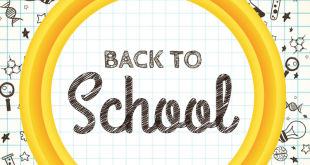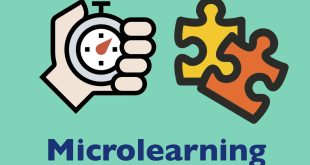Let’s imagine this scenario: it’s the new year, and you decide to change some aspects of your life – start afresh, work out more, eat healthier, sleep better, read more books, etc. Now fast forward to April; did you check everything off your goals list? Well, probably not. So, what’s the problem here? Before you start blaming yourself for constantly procrastinating and postponing your goals, think about your initial plan. Ask yourself, were my goals realistic? Is it possible to actually change almost all aspects of my life right away? Definitely not! To effectively stick to a goal, it’s important to be realistic and reasonable. If you had started with only one goal for the year, you would have probably managed to achieve it. The same thing applies to students. Teachers always expect them to follow a list of behavior goals for students in the classroom all at once. Most of the time, this will result in the reverse effect. Setting behavior goals for students is a magical strategy that many teachers swear by for disciplining their students in the classroom.
Table of Contents
What is a student behavior plan?
The essence of behavior goals for students is allowing them to be responsible for their own behavior by recording their results every day. This system generally aims at helping teachers maintain a well-behaved class to avoid class interruptions and challenges.
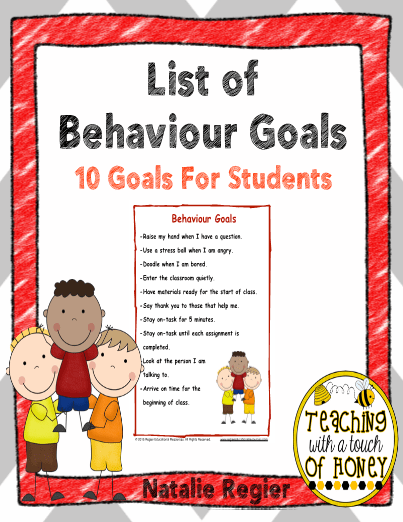
What is a positive behavior plan?
This is mainly a system that the teacher implements within the classroom to keep track of all positive behavior instances for each student after a week, month, or semester.
5 tips for struggling teachers – how do you write a behavioral plan for students?
To write some behavior goals for students, you need to first think of the behavioral problems for this particular class. If the headteacher expressed his/her concern over your class’s behavioral issues, perhaps you can specifically ask him/her for more details. This could put you at the beginning of the road to writing a plan.
Another great idea would be to ask a fellow teacher to attend a few lessons and tell you his/her notes about the class behavior. Sometimes, our own judgments are biased or unclear. So, having a new eye to oversee your class might be a good option.
After you have managed to write down the main problems that your class is facing, the next step would be to write down an actual plan. Here are five tips to get you started.
Related article: Make A Change! All about Professional Development for Teachers
1) Be honest and open with your students
Honesty is the best way to start explaining this issue to your students. Start by telling them that the class has a collective behavioral issue that needs to be resolved.
Whatever the age group you are dealing with, rest assured that they will certainly listen to what you have to say.
When you explain that their behavioral problem is causing issues for the school and that it will affect their school performance, they will take the matter seriously. If you manage to balance between a firm and calm tone, you’ll be surprised how this firmness also affects them.
An excellent way to deliver your message indirectly is to show them a video or movie scene of a disrespectful/noisy class. Ask them follow-up questions after the video to get their reactions and attitudes.
How can you describe this class using three adjectives?
Why did you choose these particular adjectives?
How do you think the teacher feels?
How do you think the teacher should react?
What kind of punishment do you think is suitable for this class’s behavior?
2) Prepare your tools to create behavioral goals for students
The right tools will certainly be quite helpful for the implementation of this plan. The first option is to prepare a bulletin board to be hung in the class where everyone can see it. Each day/week, place a big paper that includes your selected behavior goal for the entire class.
On the side, place a checklist with all the students’ names and a tick box beside each name. After each class, let each student tick beside their name whether they followed the day’s behavior plan.
Another option is to simply prepare sticky notes with the behavioral goal and stick them on each student’s desk. You can add different goals for different students if each one of them has a different behavioral issue.
One last option is to write each student’s behavioral goal on their binders/files so it accompanies them everywhere, even at home.
3) Start a reward system
All teachers know that students thrive on motivation! An excellent way to provide a good incentive for students to behave better is to implement a reward system. Start by explaining that there will be a reward for students who follow their daily or weekly behavioral goals.
Some teachers like to give stickers to students in their early years. You can also create a sticker chart, hang it in the classroom, and give out gifts when students reach 5 stickers, for example. For older students, teachers like to give them more material gifts like comic books, stationery, souvenirs, or even candy.
Other teachers prefer the promise of bonus grades for students who follow their behavioral plan. Perhaps you can start a “reward coupons” system to even motivate the students more.
4) Let students choose their own behavior goals
A great way to instill responsibility and self-discipline in your students is to let them be in charge of their own behavior management. This will also show you how each student thinks of himself/herself when it comes to poor class manners.
Teachers who have tried implementing this method report that almost 99% of the time, each student knows what they need to work on in class. This way, after each class, each student will be held accountable for his/her attitude.
You will also be able to reason with the student better if he/she is having serious behavioral problems that require extra attention. When the student is self-aware of his/her problem, this saves you so much time and effort.
5) Know your students’ impressions each day/week/quarter
It is essential to garner their feedback on a daily or weekly basis. You can sit with each student, and let them talk about what they think their behavior was like the previous week and how they feel they did on their behavior plan.
Afterward, give them your own feedback, the change in behavior that you noticed – or the lack thereof. This one-to-one talk will be great for building a bond with each student and it will motivate them to do their best efforts to avoid letting themselves down or letting you down by the end of the week.
A Teacher’s Full Guide To Student Behavior Tracking
Examples of negative student behavior
These are some common negative student behaviors that teachers always struggle with in classrooms.
- Saying rude remarks to the teacher or to a fellow classmate
- Interrupting the teacher during the lesson
- Cheating on class assignments, tasks, or tests
- Distracting other students in class

- Side talking
- Texting in class

- Sleeping during class
- Doing work for another subject while in class
- Eating in class
- Being inattentive to the teacher
- Making excuses not to do a task
- Not focusing in class

Behavioral goals for students examples
You must be thinking about what are examples of behavioral goals for students. When you’re writing out your plan to control students’ behavior, it’s essential that you think of your students’ current behavior first.
What is the current issue with my students right now?
Is the problem a whole class issue or from individual students?
How can I address these issues?
Do I want to address these issues at the same time, or focus on each one separately?
So let’s take a look at actual measurable behavioral goals examples that you can implement in your classroom. Some behavior goals for students include:
- I will focus in class.
- I will pay attention to the teacher.
- I will not eat or drink in class.
- I will not do another subject’s work in class.
- I will not sleep during class.
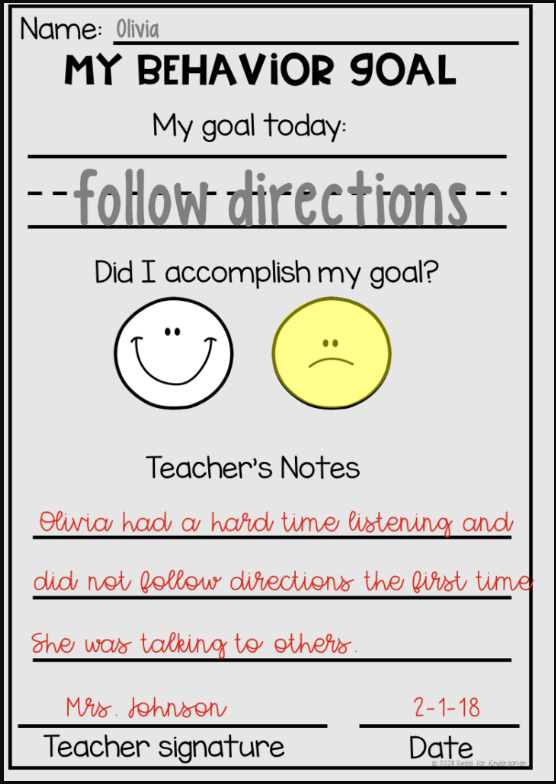
- I will not use my phone during class
- I will not talk to my friends during class.
- I will follow the teacher’s instructions.
- I can avoid cheating during classwork and tests.
- I can refrain from interrupting my teacher.
- I can say good words to my teacher and classmates.
- I will show teamwork.
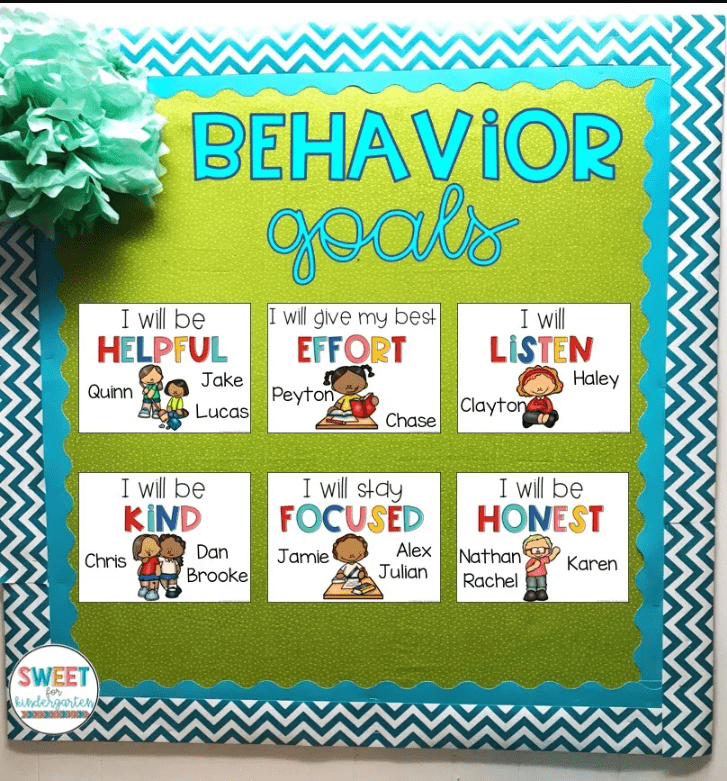
- I will not bully my classmates.
- I will not engage in aggressive physical contact with my classmates.
- I will not gossip about classmates with my friends during or after the lesson.
- I will offer help to my classmates if they need it.
- I will not chew gum during class.
- I will not write on walls or ruin school property.
- I can always be prepared with my school supplies and books for classes.
- I can refrain from laughing and making my friends laugh during the lesson.
- I can stay in my seat and ask the teacher for permission before I leave it.
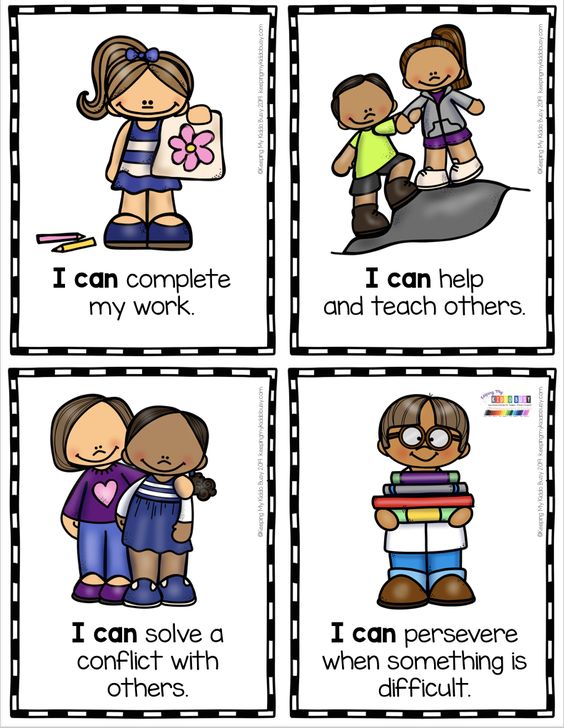
Best movies about the importance of discipline and behavior
A great way to both bond with your students and indirectly teach them about the importance of maintaining good behavior is to watch some movies with them during an extra lesson or even as part of your lessons.
Prepare some discussion questions to start a dialogue after each movie; this will allow them to think, self-reflect and engage in fruitful discussions. Some great movies that will help you set good behavior goals for students include:
- Inside out (2015)
- Home alone (1990)
- Wonder (2017)
- Soul (2020)
- The Little Prince (2015)
- Coco (2017)
Steps to take when a student displays an inability to conform to your behavior plan
If a certain student displays reckless or rude behavior or does not conform to any of the school’s behavior goals for students, teachers should resort to other strategies to address this problem. These strategies include:
-
Consider placing the student in another class
-
Include a student psychologist in the behavior plan
-
Think about changing the class setup to suit challenging students
-
Change your disciplinary measures to suit each student
-
Consider summer courses to train students further about appropriate class and school behavior
-
Include the parents in the behavior plan to extend the system at home as well
If you have never tried implementing behavior goals for students, it is time to start thinking of its benefits, uses, and classroom strategies. There are tons of teacher resources and ideas on how best to implement an effective behavior plan. Do your research, make a good tentative plan, and start seeing good results with your students!
Skolera LMS makes it easier for teachers to plan behavior goals for students, track their behavior, and generate quick reports to include in portfolios. With Skolera’s intuitive dashboard, organized calendar, and “quick create” icons, teachers can seamlessly manage their students’ behavior using uncomplicated steps.
Book your free demo with Skolera now to test the greatest teacher features.
Sources:
 Skolera LMS Blog Educational Technology Articles and News
Skolera LMS Blog Educational Technology Articles and News


